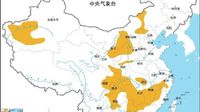On April 12, 2025, northern China experienced a severe weather event characterized by extreme winds and sandstorms, prompting the Central Meteorological Observatory to issue multiple warnings including orange gale and blue sandstorm alerts. This unprecedented weather phenomenon has significantly disrupted transportation and raised air quality concerns across the region.
The warnings indicated that strong convective weather would predominantly affect the area from morning to noon, with gusts reaching levels of 9 to 11 in the plains and exceeding level 13 in some mountainous regions. As a result, at least 3,200 domestic flights were canceled, marking the highest number of cancellations for the year, according to the civil aviation authority.
Beijing entered the period of strongest winds at 10 AM on April 12, with gusts impacting various public transportation systems. Surface elevated sections of 15 subway lines were suspended, and 221 out of 396 bus routes in mountainous areas were halted. Train services on major high-speed rail lines, including the Beijing-Guangzhou and Beijing-Tianjin routes, were also temporarily suspended.
The impact of the harsh weather extended beyond transportation. In Beijing, chain supermarkets experienced a surge in demand, leading to a brief buying spree as residents rushed to stock up on essential goods. However, the Beijing Municipal Commerce Bureau assured the public that there was no need to panic, stating that market supplies were stable and prices remained unchanged.
As the storm progressed, the Central Meteorological Observatory continued to monitor the situation, predicting that the extreme winds would persist, particularly north of the Yangtze River. Gusts were expected to reach level 10 in several areas, with coastal regions experiencing even stronger winds.
In southern China, the effects of the sandstorm were felt as dust clouds moved southward, causing significant air quality degradation. Cities in Guangdong, including Shaoguan and Guangzhou, reported rising levels of particulate matter (PM10), with concentrations reaching alarming levels. Experts noted that while it is rare for sandstorms to reach southern regions, the intensity of this particular event allowed for the dust to travel further than usual.
Experts explained that the dynamics of the storm were particularly strong, with high-altitude winds contributing to the sand’s ability to cross mountainous terrain. The Guangdong Provincial Meteorological Observatory highlighted the need for residents to take precautions, such as wearing masks and sealing windows, to mitigate health risks associated with the poor air quality.
Meanwhile, in northeastern China, heavy snowfall accompanied the extreme winds, particularly in Inner Mongolia, where blizzard conditions were expected to accumulate up to 15 centimeters of snow. This combination of severe weather conditions has led to numerous road closures and continued disruptions to rail services.
As the situation unfolded, local authorities urged residents to stay informed about travel updates and to exercise caution when venturing outdoors. The severity of the weather prompted discussions about the potential implications of climate change, as such extreme weather events become increasingly common.
By April 13, 2025, the Central Meteorological Observatory continued to issue warnings, indicating that the sandstorm and gale conditions were expected to persist. Areas north of the Yangtze River were still under threat from high winds, while southern regions remained vulnerable to the effects of the sandstorm.
In light of the hazardous conditions, the Environmental Protection Agency in Taiwan issued advisories for residents, particularly in northern areas, to wear masks due to the influx of particulate pollutants carried by the northeast monsoon. The agency reported that air quality levels were deteriorating, with PM10 concentrations reaching dangerous thresholds.
The recent weather events highlight the interconnectedness of climate systems across regions, as pollutants from northern China made their way to Taiwan, affecting air quality there as well. Public health officials in Taiwan advised residents to monitor local air quality reports and take necessary precautions to protect their health.
As the situation continues to develop, both residents and officials are grappling with the immediate impacts of this severe weather event while considering the broader implications for climate resilience and preparedness in the face of increasingly unpredictable weather patterns.
In conclusion, the extreme weather affecting northern and southern China serves as a stark reminder of the challenges posed by climate change, prompting calls for enhanced preparedness and response strategies to mitigate the impacts of such events in the future.






